Private jet catering trends & unusual requests
When it comes to what you can eat and drink on a private jet charter flight, the sky really is the limit.
Air Culinaire Worldwide are one of our catering partners, providing delicious, high quality and innovative in-flight menus for many of our flights worldwide.
We spoke to Neil Hayes, the company’s General Manager for London, and Aaron Watson, Executive Chef, to ask them about latest trends in private jet catering, some of their most memorable dishes, and the challenges of preparing refined menus at altitude.

What are the latest food trends in private jet catering? And what are your culinary predictions for 2020?
Aaron says: We do see many trends in our industry, however, our clients tend to have very specific demands that supersede any one trend or culinary strategy within our kitchens. Lately, we’ve seen a shift towards using local and organic products. Sustainability is now much more important too, which is why the ‘farm to table’ movement has been gaining so much traction over the last few years.
As for our lifestyle menu, the street food section has been very popular, alongside our healthy living section. In the food industry as a whole, trends always reflect society and its needs. We are seeing more and more companies move to more sustainable ways of operating and are being much more conscious of the environment.

For 2020, I’m especially excited by the opening of Davies & Brook by Daniel Humm in Claridge’s, as I believe that he will breathe new life into cuisine in London with his ideas and style that he’s perfected over a long period in New York. Whilst I was in NYC for the New York Lifestyle Menu launch for Air Culinaire Worldwide, I had the privilege to eat at Eleven Madison Park; the waiters are actively looking for the patrons to collaborate in their fun, but at the centre of the whole collaboration is Chef Humm’s cooking.
My favourite dishes were creations like globes of celery root braised in a pig’s bladder, inspired by the classic French dish Poulet en Vessie. A pig’s bladder flying around a copper pan en route to a table certainly stirs up the awaiting diners!
What’s the most unusual dish you’ve ever produced?
Aaron says: The most unusual dish for me was at a 2-rosette restaurant; pink-set Lamb Rump, with balsamic figs, chorizo and parmesan ice cream. At first glance, I can appreciate that it sounds like a pretty odd dish. When the idea began to unfold during the menu writing period it seemed like a big joke, but as we began to make the ice cream and saw how we could affect the taste it became the dish we worked the hardest on because, as a team, we wanted it all to work to stand out from the crowd.
Not much can compare to a new season lamb rump, so we knew we had the main event of the dish; to then mix it with sweet balsamic figs and chorizo we needed to offset all those rich flavours with something discreet and savoury. At first, guests did not know how to approach the dish when confronted with it on the tasting menu, but we knew it worked which always will put the guest at ease; they trust chefs to do the best for them. We had some fun with it. I haven’t seen many, if any, other chefs use ice cream on a hot dish.
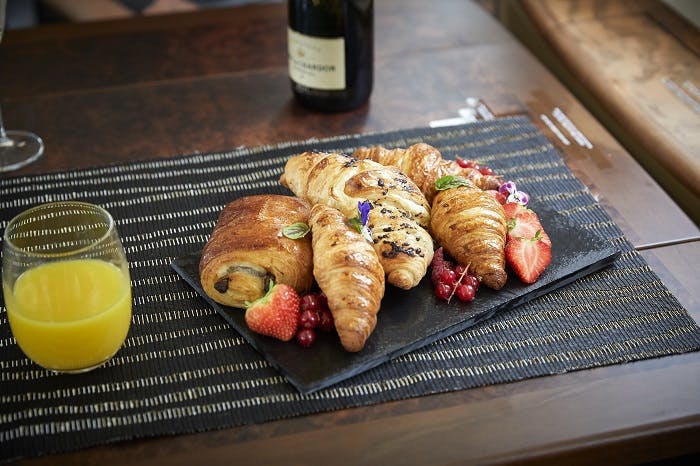
With cabin altitude affecting flavour, how are dishes prepared differently versus how you would serve them on the ground?
Aaron says: Watching Heston Blumenthal over the years in his study of how food affects the palette at a scientific level, has inspired me to use his concept ideas indirectly to create deeper flavour profiles and unlock new sensations that may also not be possible at ground level. One thing we have enjoyed a lot is mixing seaweed flavours in with premium cuts of beef.
Without going into too much detail; seaweeds are high in certain amino acids which react well with the receptors on our tongues to intensify flavours. I don’t think any chef can just add salt and pepper to the dish and expect it to wow their clients anymore.
We use a range of infused butters for our proteins to be reheated alongside; to add to that, we started to use hard herbs to create aromas through the cabin; nothing too strong as to offend or be overpowering, but just enough to enhance the environment and the flavours of the dish. Something we have begun to experiment with is marinating and using meat rubs on our proteins to try to enhance flavours also. This is often used in barbecue competitions around the world to extract as much flavour as possible.
How do you accommodate allergies, food preferences, veganism etc?
Neil says: This is an important question, and it’s a topic that has entered the limelight a lot more recently and for good reasons. It’s crucial for caterers to deal with allergies in the correct way, so we have developed a way operationally to flag any order with dietary requirements to the chefs.
We train every single staff member, whether they work in the kitchen or not, on food safety and allergens before they start working for us and we have built an extensive dietary menu for our customers and this covers all the allergens and diets. Veganism has obviously been on the rise over the last few years and has gained a lot more exposure from social media and other outlets. Personally, I’ve tried to incorporate this into my own diet more and it’s allowed me to be more creative rather than using stereotypical formulas for dishes (i.e. protein, carb and veg).
A lot of our customers are US based and we are seeing an increasing number of requests for the ‘Impossible Burger’ over the last 12 months. Impossible foods are a company based in California that have developed plant-based substitutes for meat products. They isolated the molecule (heme) that essentially makes meat taste like meat, and this is found in every living plant and animal on the planet. They first used soybean plants to extract heme, but now use the DNA from these soybean plants and combine it with genetically engineered yeast.
The result is a quite remarkable product that gives you the taste and nutritional benefits of meat, all from a plant! Genetical engineering might sound like a scary term when it comes to food, but with climate change being at the forefront of the modern world, it’s important the industry starts to think differently.
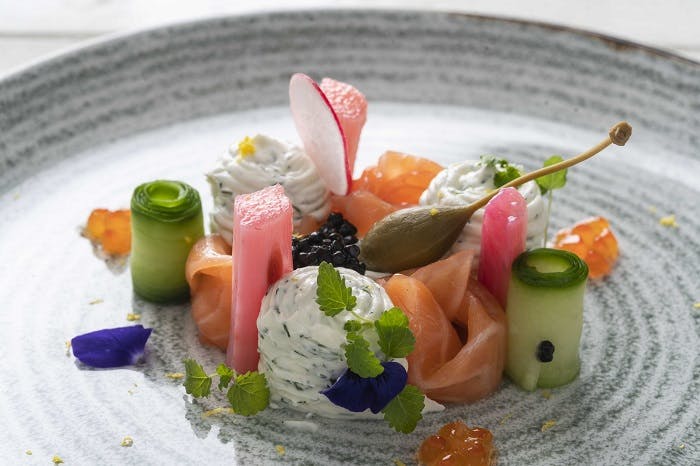
What is the most popular menu item you provide?
Aaron says: In my opinion, the British Smoked Salmon is the most popular dish. It’s bright, vibrant with full-bodied flavours, can be served in several ways and has a premium look on the plate. We serve it with poached rhubarb, pickled cucumber and a dill cream cheese. All of these elements are added to elevate the dish.
Also, a great dish is the Raspberry and Dark Chocolate Delice. The menu item itself is extremely complex in its preparation and with many stages of layering to achieve the final product. The dish itself is very summery and light. The chocolate glaze makes it luxurious and decadent and again the garnish and presentation make this a real high-end product promising to wow any client.
What’s your own personal favourite dish?
Neil says: The Roasted Lamb Rump, which is on our fine-dining menu. For me, the balance on this dish is perfect. Smigee mushrooms gives the acidity on one side, a creamy and rich cauliflower puree on the other, and the neutral salsify gives the perfect canvas for the juicy tender lamb rump. It’s served with a beautiful rosemary jus that brings it all together.
I am a big fan of the testing phase during our new menu process, for obvious reasons, and this was the first dish that we tried and tested on our newest London Lifestyle Menu. It really set the standard high.
I’m also a big fan of our street food menu, specifically the Buttermilk Chicken Goujons. It might not sound glamourous, but it’s the taste and feeling of comfort that really matters here. We soak the chicken overnight in buttermilk, then double pane in seasoned breadcrumbs. They are then lightly fried for authenticity and finished in the oven.
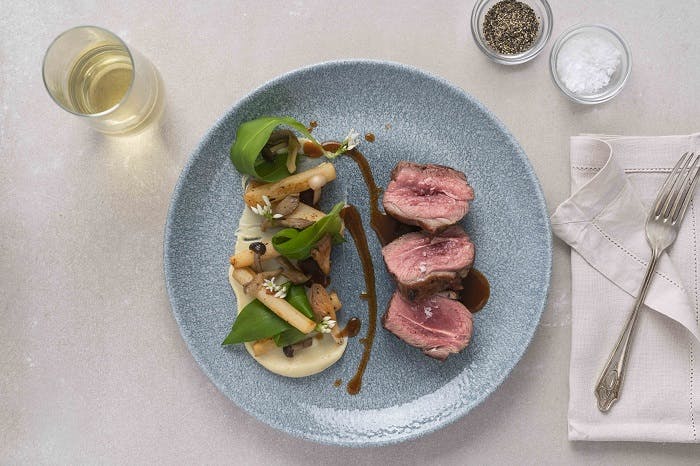
With space limited onboard the aircraft, how much is pre-prepared versus finished onboard?
Neil says: This really depends on the type of aircraft being used and the equipment available. For European flights, it’s common to only have cold food (like sandwich trays, fruit trays) and these are all ready to serve. However, for the longer flights or when the flight attendant would like to give the passenger something a bit more special, then we provide the dishes in kit form, with detailed instructions on how to reheat and serve.
Even on the larger aircraft the galleys are tight, so it’s important that we think carefully about the amount of packaging we use, but also how easy it is for the flight attendant to follow. Last year, Aaron and I had the pleasure of spending three days onboard a private A340 for a client’s photoshoot. We had four dishes to prepare and serve on their china and even on an aircraft this size, it was eye opening to see the space flight attendants work with.
It’s crucial to be organised and have minimal packaging, but it’s equally important to have the correct flow to match the packaging with the cooking instructions so that the flight attendant can be efficient with the space they have available.
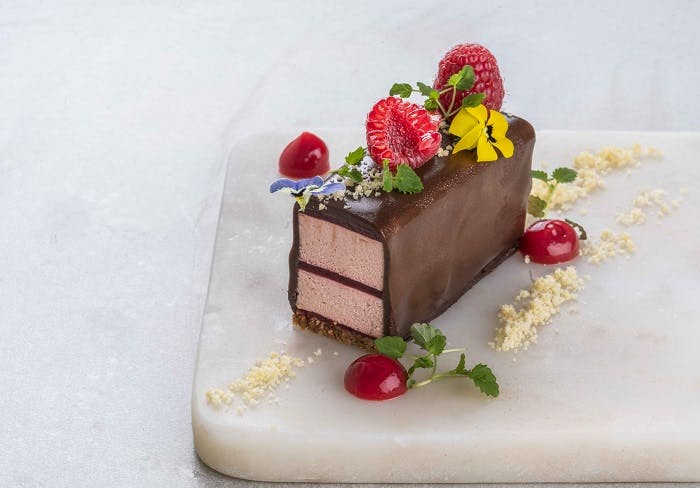
Tell us a bit more about Air Culinaire Worldwide and how you work?
Neil says: Air Culinaire Worldwide is a global company that services over 1800 locations. The United States has the largest number of kitchens, with a total of 20 locations. In Europe, we have 2 in the UK and 1 in Paris, France. In addition to owned-and-operated kitchens, we have a network which is the result of strong partnerships with hundreds of caterers, hotel groups and restaurants.
The network has operated for over 12 years and the company works diligently to find partners that adhere to the same standards of customer service, accountability and product quality. As of 2019, there are over 1600 locations services within this network, which gives us the largest coverage of any business aviation caterer in the industry.
I oversee our two London kitchens, which are based at Luton Airport and Biggin Hill Airport. From these, we service all the major airports in London, and many more in the surrounding areas. We source as much as possible locally, and have built our menus with seasonality in mind, so that we can provide dishes using the highest quality ingredients, at the right time of year.
Our chefs like to be challenged and enjoy working on orders that require them to research and think about the products they are using, as it keeps their creative juices flowing. In the past, on the quieter days, although these are increasingly rare now, we have run our own version of Master Chef to keep them on their toes. They essentially get given a box of ingredients and an hour to come up with a dish which we all taste and give feedback. It keeps us close as a team but also allows us to experiment with different flavour profiles for our menus.
Our Client Services team work with catering companies to ensure that every flight is a delicious experience. For advice on the options available on your next flight, contact us or call +44 (0)20 7100 6960 (24 hours).
Related content

Relocating by private jet
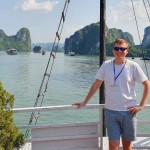
PrivateFly’s team travel resolutions for 2020



